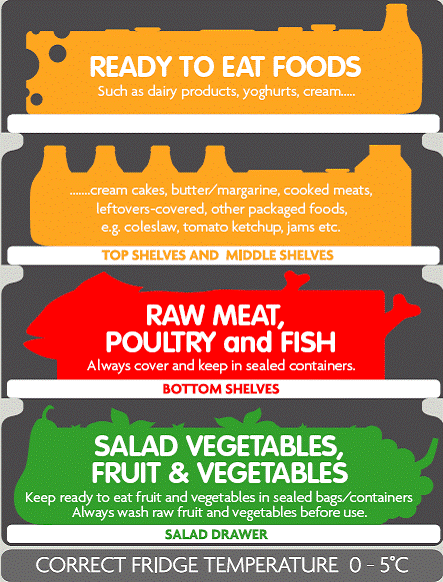Food safety
1/17
There's no tags or description
Looks like no tags are added yet.
Name | Mastery | Learn | Test | Matching | Spaced |
|---|
No study sessions yet.
18 Terms
Fridge storage
temp between 0oC and 5oC
bacteria multiplies slower- no warmth
high risk foods stored in fridge
cool food before refrigerating
use date marks to rotate stock
ensure spaces between items so air can circulate
Stock rotation

Freezer storage
temp at -18oC or colder
bacteria becomes dormant- no moisture to multiply- enzymes may still be active
freezers must be defrosted once a year to avoid a build up of ice
ensure spaces between items so cold air can circulate
Stock rotation
Preferably allow food to defrost naturally
How to stop the spread of bacteria when preparing, cooking and serving food?
Wash hands, keep fingernails short
Don’t cough, sneeze over food, tie hair back, wear clean apron
Clean work surfaces with antibacterial sprays Food handler
Keep raw and cooked food separated and separate utensils
Cook food to above 75C and cook for the correct time to kill pathogenic bacteria
Use by/ best before dates
best before: sensory qualities (flavour, texture) safe to eat after e.g. bread, cereal (plant)
use by: unsafe to eat after, moist, stored in fridge- could cause food poisoning e.g. chicken, fish (animal- high in protein)
How to use a temperature probe
Disinfect the probe before and after each use
Switch on
Insert probe into thickest part of the food
Wait for gauge to settle
Temperature should reach 75oC
If not reached, cook for longer and repeat
How does yeast spoil food?
Reproduce by bubbling- in air all around us
Can grow with or without oxygen
Prefers moist, acidic or high sugar foods e.g. orange, jam
Best in warm conditions 25-29C, destroyed at temp over 55C
How does mould spoil food?
Tiny fungus- in air all around us
Likes high sugar/salt food- can grow on dry foods
Mould spreads harmful substances deep into food
How does bacteria spoil food?
Single celled microorganisms- harmless, pathogenic and food spoilage bacteria (causes good to smell and lose flavour and texture)
Bacteria like warm, moist, neutral foods high in protein e.g. meat, milk, cooked rice
How to control bacteria?
Take away warmth, moisture and time
Remove (high risk foods) from danger zone 5C-63C and keep above (preferably 75C)
Fridge 0 to 5C- slows down bacteria growth and slow multiplying
Freezer -18 to -25C- bacteria dormant
Enzymic browning
Enzymes mixing with oxygen in the air- spoiling food
Prevent- use acid, blanching fruit and veg
Symptoms of food poisoning
Vomiting
Diarrhoea
Different types of bacteria
Salmonella- undercooked meat
Listeria- soft cheese, pate
E Coli- undercooked meat
Campylobacter- poultry, meat
Oxidation
If you expose food to heat or air you lose water soluble vitamins
Microorganisms in food production
Yeast- bread making- warmth, food, time and moisture, fermentation, fungus
Mould- develop flavour in cheese, ripen the surface of some sausages
Bacteria- harmless bacteria added to warmed milk- kept warm to allow bacteria to multiply
Use of bacteria in food production
Cheese making- sours milk to create curds and whey, changes actors into lactic acid, which lowers the pH of the milk and starts the cheese making process
Yoghurt making- bacteria added to warmed milk and allowed to multiply at 40C- lactose turns into lactic acid that denatures and coagulates the protein in the milk to thicken the yoghurt
Bacterial contamination sources
Raw food- cross contamination
Work surfaces- use antibacterial sprays
Food handler- use tongs, don’t lick fingers
Pests- insects, mice, empty bins
Who is more at risk from food poisoning?
Babies, young children, elderly, pregnant women, reduced immune system
Causes of food poisoning?
Undercooked food
Incorrect fridge temp (0-5c)
Cross contamination